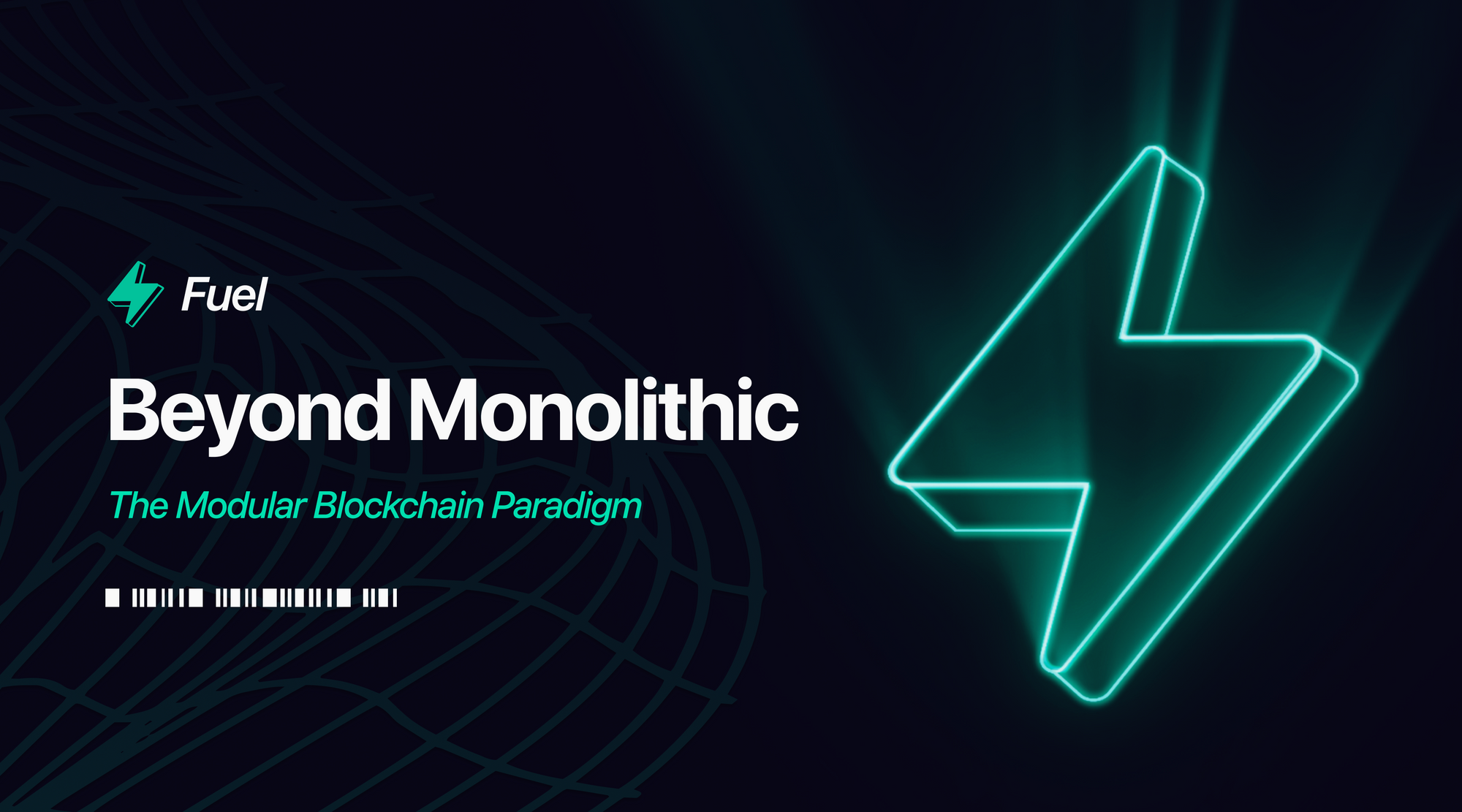Beyond Monolithic: The Modular Blockchain Paradigm
How modular design will enable blockchains to scale by orders of magnitude.

This article has been translated by the Fuel Ambassadors in Russian.
The Modular Blockchain Paradigm
Modular blockchains are the latest paradigm in blockchain design. Originated by Celestia, the concept of modularity is rapidly becoming a category-defining narrative when it comes to the challenge of scaling blockchains by orders of magnitude.
But why do we need modular blockchains? Consider the following four theses:

Based on these principles, it becomes clear that we need to look to new paradigms in order to achieve our vision for web3. Modular blockchains are the most promising new paradigm.
What is a Modular Blockchain?
Before diving deeper into the four statements above, it is important to understand the basics of monolithic and modular blockchains.
The core functions of a blockchain are:
- Execution - Transaction processing and computation.
- Settlement - Dispute resolution and bridging.
- Consensus - Transaction ordering.
- Data availability - Ensures data is available.
Traditionally, blockchain designs have been monolithic. This means that all the functions of the blockchain are handled on a single layer.
The thesis of modular blockchains is that a single blockchain doesn’t need to handle all these components on its own. Instead, by disaggregating these core components, individual blockchains can focus on specializing in a specific area, leading to significant optimizations.

A modular blockchain stack consists of layers of modular blockchains which rely on each other to create a system with all of the above components. A modular blockchain is any chain which is part of a modular blockchain stack.
Modular blockchain (noun): a blockchain that fully outsources at least one component to an external chain:
— Celestia (@CelestiaOrg) June 27, 2022
- Execution
- Settlement
- Consensus
- Data availability
Why Modular?
Fundamentally, blockchains are designed to protect and promote the sovereignty of the individual. Our vision for web3 is a world where the systems that form the fabric of our digital world are accessible by everyone, and are decentralized, scalable, and secure.
Above, we considered four statements which justify the development of a new paradigm for blockchains - specifically, the modular paradigm. Let's explore these further.
1 - Increased Throughput is Essential In Order to Achieve our Vision for Web3
Despite the expansive ecosystem of existing blockchains, demand still far outstrips supply when it comes to throughput. This leads to network congestion, making blockchain networks increasingly inaccessible for many potential users.

This challenge has plagued the blockchain space since its inception, even though adoption is still relatively low. Without new technologies to increase throughput, it will only become more of a problem as adoption scales to the billions.
To achieve our vision of making web3 systems accessible by everyone, they need to be able to scale accordingly. Mass adoption requires a massive increase in transactional and computational throughput.
2 - Decentralization is Essential In Order to Achieve our Vision for Web3
Decentralization is the key differentiator between web2 and web3 systems, and as such should be the core focus of any web3 system. Without decentralization, web3 systems are no better than their web2 predecessors.
The following principles are essential to achieving decentralization:
- Openness - Anyone can view and access the system.
- Verifiability - Anyone can verify the validity of the system. Any user can operate a node and guarantee that the blockchain is operating correctly and that its rules are being upheld by validators.
- Censorship resistance - Anyone can participate in the system as a user without the risk of being locked out by validators.
Thus, in order to achieve our vision for web3, any blockchain system must guarantee openness, verifiability, and censorship resistance - and all at a scale that can service billions of users.
3 - Increasing Throughput Without Maintaining Decentralization is Not Scaling
The now-notorious Blockchain Scalability Trilemma describes the compromise monolithic blockchains must make between security, throughput, and decentralization. In order to improve one of these three components, sacrifices must be made in one or more of the others.

Plenty of existing blockchains promise high throughput. However, in order to achieve this, they often make unacceptable sacrifices when it comes to decentralization.
In today’s monolithic blockchain systems, increased throughput is correlated with an increased cost to verify the chain. As blocks become larger or more frequent, the resource requirements for verifying the validity of a block and/or blockchain increase. As such, fewer users are able to verify the chain, instead having to rely on an increasingly centralized group of trusted third parties to run nodes.
It is important to note: sacrificing decentralization to increase throughput is not scaling.
While the term “scalability” has often been used to refer to a blockchain’s capacity to process transactions, there is a movement to redefine scalability as a blockchain’s throughput divided by the cost to verify the chain.

Under this definition, in order to scale, blockchains must increase throughput without increasing the cost to verify the network. This kind of “true scalability” is what modular blockchains are designed to enable.
4 - Current Monolithic L1 and L2 Scaling Solutions are Not Sufficient to Achieve True Scalability
There are many proposed scaling solutions for monolithic blockchains, some of which are already under development. Solutions like sharding, rollups, fraud/validity proofs, and light client innovations aim to increase throughput without increasing the cost to verify the network.
Some of these solutions are adopting aspects of modularity in order to scale, such as outsourcing execution to L2s. However, L2s are severely restricted by the performance of the main network, so as long as they continue to rely on monolithic L1s for finality, the scalability trilemma remains an issue.
For example, rollups on Ethereum post their blocks directly to the Ethereum blockchain, essentially using L1 Ethereum as a settlement, consensus, and data availability layer. The problem with this is that Ethereum is already congested, and rollups are competing for bandwidth with users of “monolithic Ethereum” (i.e. non-rollup use cases).
Because of their growing popularity, rollups are causing further congestion on Ethereum, thereby inadvertently driving Ethereum toward a more modular-first design. For example, there are already several proposals to make gas costs cheaper for rollups on Ethereum (i.e. prioritizing modularity), but this move is controversial, as it will make typical Ethereum transactions more expensive, essentially forcing users of L1 Ethereum to subsidize rollups.

This conflict between modular and monolithic use cases of Ethereum means it is failing to effectively optimize for modularity. As long as it remains unspecialized, it will have reduced scale compared to modular-first alternatives.
True scalability - that is, massively increased throughput which preserves decentralization - is not a viable goal for monolithic blockchains. In order to scale, chains like Ethereum will need to optimize for modularity, which will mean outsourcing execution entirely.
The Promise of Modular Blockchains
Novel modular blockchain systems are designed from the ground up to solve barriers to scalability. Rather than building on top of dated technology, the aim is to learn from the suboptimal elements of previous generations of blockchain tech and create an entirely new paradigm which optimizes for scalability and decentralization while maintaining security.
In a modular system, protocols can specialize their offering for a specific layer in the stack. With teams like Celestia working on a dedicated data availability and consensus layer, there is a new drive for projects which optimize for solving bottlenecks on the execution layer. Fuel is tackling this challenge by building the world’s fastest execution layer for the modular stack.
Unconstrained by the limitations of Ethereum and the EVM, Fuel approaches scalable execution from a modular-first perspective, allowing for significant improvements over the EVM’s inefficient execution environment and thus enabling maximum decentralization and the highest flexible throughput.
With this new movement, we have an opportunity to start fresh and build a fundamentally new generation of blockchains that go beyond monolithic.
Follow Us
About Us
Fuel is the fastest execution layer for the modular blockchain stack. Powerful and sleek, the technology enables parallel transaction execution, empowering developers with the highest flexible throughput and maximum security required to scale. Developers choose the FuelVM for its superior developer experience and the ability to go beyond the limitations of the EVM.

